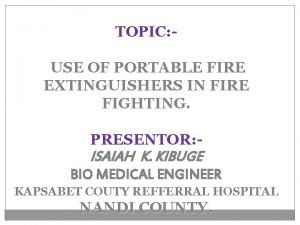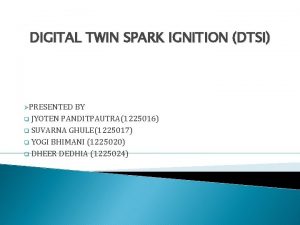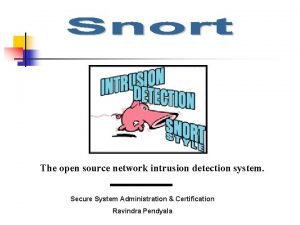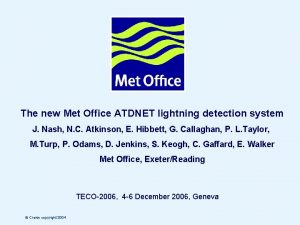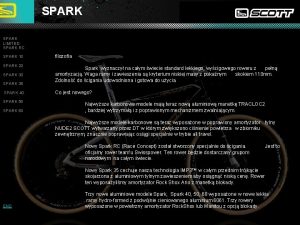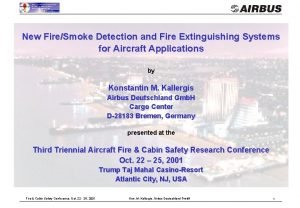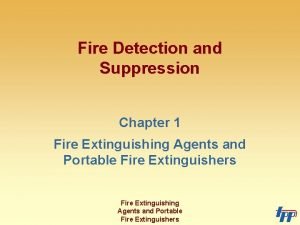Spark Detection and Extinguishing System Spark Detection markets






























- Slides: 30

Spark Detection and Extinguishing System

Spark Detection – markets n Initiative from Finnish insurance companies o Need for technically competitive and cost efficient Spark Detection System n ATEX (94/9/EY, 1992/92/EY) directives o Regarding potentially explosive atmospheres and machines and devices used in them. o State council statute obligates employers to evaluate possible risks regarding dust explosions and in case of risk move to corrective actions

Spark Detection – Dust explosion n Dust explosion is a fast burning reaction. n Dust explosion moves forward from the ignition point spherically lifting pressure and thus causing damage to constructions n Dust explosion is possible, when there is enough fine material mixed with air and a spark or high enough temperature n Material can be almost anything as long as it is fine enough.

Spark Detection – What it does n The purpose of the system is to extinguish the detected sparks before they cause a dust fire or a dust explosion. n Following systems can be protected with the system: o Saw dust outlet systems o Dust outlet systems o Grinders and pellet burners n Spark detection and extinguishing system is not used for protecting rooms

Spark Detection – markets n Applications in mechanical wood processing industry and more accurately: o sawdust outlet pipes, conveyors etc n Potential customers: o carpenters, sawmills, planing mills, furniture factories, schools, paper mills…

Spark Detection – Principle Saw dust outlet pipe Extinguishing unit Spark detectors Air flow n 1. Spark detectors and extinguishing unit o Basic system includes only two detectors and an extinguishing unit o Extinguishing unit is a part of the Spark detection system

Spark Detection – Principle Saw dust outlet pipe Panel Extinguishing unit Spark detectors n 2. Detectors, extinguishing unit and panel o By adding a panel to the system, it is possible to – get info of the possible alarms (siren and beacon) – shut down machines in the production process – test the system Air flow

Spark Detection – Principle Saw dust outlet pipe Panel Extinguishing unit Spark detectors Air flow n 3. Detectors, extinguishing unit, panel and FX 3 NET o Spark detection system panel can be connected to a control computer via Mod. Bus-fieldbus. This enables for example the monitoring of alarm log FX 3 NET

Spark Detection – connection to fire alarm panel n The system is usually used as an individual system n The system can be connected to a fire alarm panel, if: o the alarm needs to be transmitted to the fire brigade o the alarm information needs to be tranferred to the fire alarm panel locally

Spark Detection - System n The system consists of three different main blocks: n Detection o Detectors o Test lamp n Control o Control Panel o Alarm devices (sounder and beacon) o Signal router n Extinguishing o Extinguishing unit o Pressure boost unit

Spark Detection – System Components n The System consists of three main blocks o Spark detector - Detects the sparks and controls the extinguishing unit - Transmits the info about the extinguishing events to the panel - Measure area UV - IR o Fulfils the requirements of: EN 50081, EN 50082, EN 50130 -4, EN 541, IEC 60068 -1/2

Spark Detection – System Components o Spark detection panel - Works as a human interface - Shuts down machines in alarm state - Measures device temperatures - Communicates with control computer via Mod. Bus (option) - System can be connected to Esmi FX Fire panel Integration

Spark Detection – System Components o Extinguishing unit – Extinguishes sparks with a fine water screen. Extinguishing unit is fault monitored by a flow switch and also by the panel. – Extinguishing unit is used in saw dust outlets under 450 mm diameter – The self cleaning unit is designed so that the particles flying in the pipe will not damage it Extinguishing unit

Spark Detection – System Components o Extinguishing unit – Extinguishes sparks with a fine water screen. Extinguishing unit is fault monitored by a flow switch and also by the panel. – Extinguishing unit is used in saw dust outlets over 450 mm diameter – The self cleaning unit is designed so that the particles flying in the pipe will not damage it Extinguishing unit

Spark Detection – System Components o Pressure booster (part of the extinguishing unit) – Requirements for the water and electric suplies: • Water pipe min. DN 28 and flow 100 l/min/nozzle • Motor voltage 3*400 V and current 5 A Pressure booster consists of a water pump and diaphragm pressure tank

Spark Detection – Installation requirements n Pressure booster o Electrical connections has to be done by an electrician o Pipework has to be done by a plumber n Planning or installing of Spark detection systems in Finland does not require same kind of qualifications as in case of sprinkler systems. n Spark detection systems are not EN standardised. Planning and installations should done according to European Insurance Committee: CEA 4044 - Specifications for spark detection, spark extinguishing and spark diversion systems – Planning and Installation

Spark Detection – System Components

Spark Detection – System Components 120 Spark detectors and AN 6400 Panel

Spark Detection – System Components Extinguishing unit

Spark Detection – System Components Pressure booster

Spark Detection – System Components Alarm devices, siren and beacon

Spark Detection – System Components Temperature monitoring

Spark Detection – System Components Expansion options

Spark Detection – System planning n System response time from detection to extinguishing is <100 ms n Extinguisher units are installed in direction of air flow after the detectors Detector Extinguishing unit

Spark Detection – System planning n The distance between extinguishing unit and detector is calculated with the following formula d= F x 2 D, where d = min. installation distance F = air flow speed (typ. 20 -30 m/s) D = System delay (<100 ms) Calculated with 25 m/s air flow d = 5 m Manufacturers ”thumb rule” d = 7 m d

Spark Detection – System planning n The bigger the diameter of the pipe is, the more water has to be injected into it. The needed water amount can be calculated with the following formula: Q = F x A x B, where Q = water amount needed l/s F = air flow speed (typ. 20 -30 m/s) A = pipe cross area π x r² B = constant 0, 2 l/m³ (0. 2 litres water / 1 m³ air)

Spark Detection – extinguishing unit / nozzle n Nozzle in the pipe on the left n In this picture there is a nozzle designed for 400 mm pipe in a 700 mm pipe

Spark Detection – Installation pictures Detectors and a test lamp n Detectors are installed facing each other on the sides of the saw dust outlet pipe. This way maximum visibility of the detectors is achieved. n Detectors must not be installed in the bottom of the pipe. Danger of coverage. n Detectors must not be installed just after a corner. Danger of breakage. Signal router

Spark Detection – Installation pictures Detectors Signal router Detectors and Signal router Sounder and Beacon Extinguishing unit Panel Pressure Booster

Spark Detection – Advantages n Smallest detector in the market o Very fast response time (1 ms) n Fastest System response time on the market n Detector and extinguisher can be installed near to each other thanks to fast System response time o - > less extinguishers outdoors -> less separate extinguisher warmers o Minimized extinguishing water -> less problems with filters n User friendly, easy user interface n Cost effective compared to earlier systems on the market
 Starving in fire fighting
Starving in fire fighting Nfpa 2010
Nfpa 2010 Spark sql: relational data processing in spark
Spark sql: relational data processing in spark Anomaly detection spark
Anomaly detection spark Spark payroll and administrative
Spark payroll and administrative Dtsi means
Dtsi means Nids open source
Nids open source Cavitation inspection
Cavitation inspection Bro ids
Bro ids System log analysis for anomaly detection
System log analysis for anomaly detection Atd lightning detection system
Atd lightning detection system Financial markets and institutions chapter 1
Financial markets and institutions chapter 1 Financial intermediaries ppt
Financial intermediaries ppt Consumers, producers, and the efficiency of markets
Consumers, producers, and the efficiency of markets New market tax credits 101
New market tax credits 101 Buyer behaviour
Buyer behaviour Chapter 9 expanding markets and moving west
Chapter 9 expanding markets and moving west Business buyer behaviour
Business buyer behaviour Analyzing business markets chapter 7 ppt
Analyzing business markets chapter 7 ppt Product market boundaries and structures
Product market boundaries and structures Buyer influences in business markets
Buyer influences in business markets Financial intermediaries ppt
Financial intermediaries ppt Urban economics and real estate markets
Urban economics and real estate markets Dartmouth sociology
Dartmouth sociology Mutual fund flows and performance in rational markets
Mutual fund flows and performance in rational markets Types of financial intermediaries
Types of financial intermediaries Changes in an individual's behavior arising from experience
Changes in an individual's behavior arising from experience Organizational buyer
Organizational buyer Target markets and channel design strategy
Target markets and channel design strategy Chapter 5 consumer markets and buyer behavior
Chapter 5 consumer markets and buyer behavior International financial markets and instruments
International financial markets and instruments
